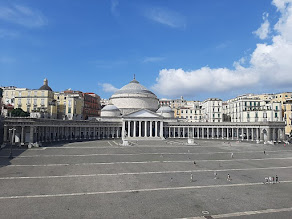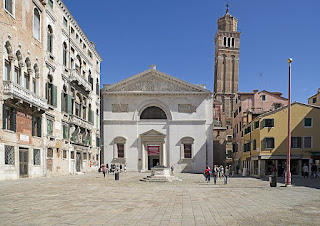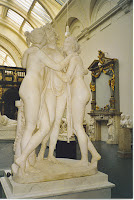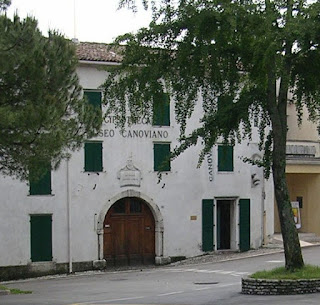Oldest opera house in the world opens its doors in Naples
Teatro di San Carlo in Naples was officially opened on this day in 1737, way ahead of Teatra alla Scala in Milan and Teatro La Fenice in Venice.
 |
| Teatro di San Carlo opened on 4 November 1737 with a performance of Mestastasio's Achille in Sciro |
Originally known as the Real Teatro di San Carlo, the theatre was designed by Giovanni Antonio Medrano for the Bourbon King of Naples, Charles I, and took just eight months to build.
Medrano was primarily a military architect, but he was advised by Angelo Carasale, the former director of the Teatro San Bartolomeo, which the San Carlo was to replace.
Incorporating 184 boxes plus a 10-seater royal box, the theatre had a capacity of more than 3,000 people, although modern safety regulations limit today's theatre to 1,386 seats.
The official inauguration was on the King’s saint’s day, the festival of San Carlo, on the evening of 4 November. There was a performance of Achille in Sciro by Pietro Metastasio with music by Domenico Sarro, who also conducted the orchestra for the music for two ballets.
This was 41 years before La Scala and 55 years before La Fenice opened. San Carlo is now believed to be one of the oldest, if not the oldest, remaining opera houses in the world.
Both Gioachino Rossini and Gaetano Donizetti served as artistic directors at San Carlo and the world premieres of Donizetti’s Lucia di Lammermoor and Rossini’s Mosè were performed there.
In the
magnificent auditorium, the focal point is the royal box surmounted by the
crown of the Kingdom of the Two Sicilies.
It is a lasting demonstration of the power of the Bourbon King Charles I in Naples at the time, which, thankfully, he used to give the city, and the rest of the world, a magnificent opera house.
Close to Teatro San Carlo in the centre of Naples, Galleria Umberto I, Caffè Gambrinus, the church of San Francesco di Paola and Palazzo Reale are all well worth visiting. The Gambrinus is an historic coffee house situated next to the start of Via Chiaia. It was was founded in 1860 by Vincenzo Apuzzo, whose dream was to make his cafe the most important of the newly unified Italy. The next owner, Mario Vacca, began a refurbishment programme and commissioned numerous contemporary artists to provide decoration. Their artwork still graces the elegant Art Nouveau interiors. Later, the Gambrinus became known as a meeting place for intellectuals and artists, among them Gabriele D'Annunzio and Filippo Tommaso Marinetti, Oscar Wilde, Ernest Hemingway and Jean Paul Sartre.
Travel
Tip:
National Unity and Armed Forces Day (Giorno dell’Unità Nazionale e Festa delle Forze Armate) is a day of celebration held in Italy on or close to 4 November each year. Originally conceived as a way to to commemorate the victory over Austria-Hungary in 1918, which to many marked the completion of Italian unification, it was somewhat hijacked as a celebration of military strength under Mussolini, who renamed it as the Anniversary of Victory. After World War Two, there was a reassertion of the sense that the celebration was about unity rather than a battlefield triumph. A national holiday until 1976, it became a moveable celebration after that and declined in importance for a while in the 1980s and '90s before being revived by former president Carlo Azeglio Ciampi. You may still see parades and celebrations of the day, which was marked with particular ceremony on the centenary of the end of World War One in 2018, with events held in Trieste and Trento, two cities at the forefront of the victory in 1918, as well as in Rome.
The official inauguration was on the King’s saint’s day, the festival of San Carlo, on the evening of 4 November. There was a performance of Achille in Sciro by Pietro Metastasio with music by Domenico Sarro, who also conducted the orchestra for the music for two ballets.
This was 41 years before La Scala and 55 years before La Fenice opened. San Carlo is now believed to be one of the oldest, if not the oldest, remaining opera houses in the world.
Both Gioachino Rossini and Gaetano Donizetti served as artistic directors at San Carlo and the world premieres of Donizetti’s Lucia di Lammermoor and Rossini’s Mosè were performed there.
 |
| Teatro di San Carlo is a short walk from the Piazza del Plebiscito in the heart of Naples |
It is a lasting demonstration of the power of the Bourbon King Charles I in Naples at the time, which, thankfully, he used to give the city, and the rest of the world, a magnificent opera house.
Since then, San Carlo has suffered partial destruction in a fire in 1816 and was damaged by bombing raids in World War Two, although not too severely. It was open for business again within two months of Naples being liberated by the Allies in October 1943, relaunching on 26 December of that year with a performance of Puccini's La bohème.
Ironically, the great Neapolitan tenor, Enrico Caruso, did not enjoy a good relationship with San Carlo. From 1901 onwards, after being booed by a section of the audience during a performance of Donizetti's L'elisir d'amore, Caruso refused to sing there again.
Travel
Tip:
 |
| The Caffè Gambrinus has a long and illustrious history as a meeting place in the heart of Naples |
Close to Teatro San Carlo in the centre of Naples, Galleria Umberto I, Caffè Gambrinus, the church of San Francesco di Paola and Palazzo Reale are all well worth visiting. The Gambrinus is an historic coffee house situated next to the start of Via Chiaia. It was was founded in 1860 by Vincenzo Apuzzo, whose dream was to make his cafe the most important of the newly unified Italy. The next owner, Mario Vacca, began a refurbishment programme and commissioned numerous contemporary artists to provide decoration. Their artwork still graces the elegant Art Nouveau interiors. Later, the Gambrinus became known as a meeting place for intellectuals and artists, among them Gabriele D'Annunzio and Filippo Tommaso Marinetti, Oscar Wilde, Ernest Hemingway and Jean Paul Sartre.
.jpg) |
| President Sergio Matarella leads part of the ceremony in Rome in 2018 |
National Unity and Armed Forces Day (Giorno dell’Unità Nazionale e Festa delle Forze Armate) is a day of celebration held in Italy on or close to 4 November each year. Originally conceived as a way to to commemorate the victory over Austria-Hungary in 1918, which to many marked the completion of Italian unification, it was somewhat hijacked as a celebration of military strength under Mussolini, who renamed it as the Anniversary of Victory. After World War Two, there was a reassertion of the sense that the celebration was about unity rather than a battlefield triumph. A national holiday until 1976, it became a moveable celebration after that and declined in importance for a while in the 1980s and '90s before being revived by former president Carlo Azeglio Ciampi. You may still see parades and celebrations of the day, which was marked with particular ceremony on the centenary of the end of World War One in 2018, with events held in Trieste and Trento, two cities at the forefront of the victory in 1918, as well as in Rome.
More reading:
Also on this day:
(Picture credits: Teatro di San Carlo by Radomil Binek; Piazza del Plebiscito by Baku; Caffè Gambrinus by Armando Mancini; Sergio Matarella by Quirinale.it; via Wikimedia Commons)








